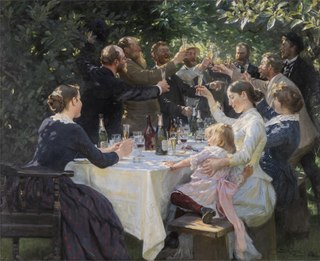
Disco is a genre of dance music and a subculture that emerged in the 1970s from the United States' urban nightlife scene. Its sound is typified by four-on-the-floor beats, syncopated basslines, string sections, brass and horns, electric piano, synthesizers, and electric rhythm guitars.

A party is a gathering of people who have been invited by a host for the purposes of socializing, conversation, recreation, or as part of a festival or other commemoration or celebration of a special occasion. A party will often feature food and beverages, and often conversation, music, dancing, or other forms of entertainment.

Christmas Eve is the evening or entire day before Christmas Day, the festival commemorating the birth of Jesus. Christmas Day is observed around the world, and Christmas Eve is widely observed as a full or partial holiday in anticipation of Christmas Day. Together, both days are considered one of the most culturally significant celebrations in Christendom and Western society.

In the Gregorian calendar, New Year's Eve, also known as Old Year's Day, is the evening or the entire day of the last day of the year, 31 December. In many countries, New Year's Eve is celebrated with dancing, eating, drinking, and watching or lighting fireworks. Some Christians attend a watchnight service. The celebrations generally go on past midnight into New Year's Day, 1 January.

Italo disco is a music genre which originated in Italy in the late 1970s and was mainly produced in the 1980s. Italo disco evolved from the then-current underground dance, pop, and electronic music, both domestic and foreign and developed into a diverse genre. The genre employs electronic drums, drum machines, synthesizers, and occasionally vocoders. It is usually sung in English, and to a lesser extent in Italian and Spanish.

The observance of Christmas around the world varies by country. The day of Christmas, and in some cases the day before and the day after, are recognized by many national governments and cultures worldwide, including in areas where Christianity is a minority religion. In some non-Christian areas, periods of former colonial rule introduced the celebration ; in others, Christian minorities or foreign cultural influences have led populations to observe the holiday.
A radio format or programming format describes the overall content broadcast on a radio station. The radio format emerged mainly in the United States in the 1950s, at a time when radio was compelled to develop new and exclusive ways to programming by competition with television. The formula has since spread as a reference for commercial radio programming worldwide.
Presuntos Implicados was a Spanish pop band, created in March 1983 in Yecla, Murcia. The band was originally composed of the siblings Sole Giménez and Juan Luis Giménez, and their friend Pablo Gómez. In the same year 1983, they won a radio contest and their first recording, Danzad, Danzad Malditos, appeared one year later under the RCA label. But the record company forced them to write more commercial songs outside their style, and they left in 1986 to work with an independent label, Discos Intermitentes. Pablo Gómez left the group and Javier Vela arrived to replace him.
D.C. LaRue is an American singer, songwriter and producer. His music was successful in clubs and on dance music charts worldwide during the 1970s and early 1980s.

WMYX-FM is a commercial radio station in Milwaukee, Wisconsin, US. Calling itself "99-1 The Mix", it was the first station in the U.S. to use the "Mix" moniker. WMYX-FM has been airing roughly the same hot adult contemporary radio format since late 1981. The station is owned by Audacy, Inc., along with sister stations WXSS-FM and WSSP. WMYX's studios and transmitter are co-located in Hales Corners. The playlist consists of current hits and recent hits from the 2000s and 2010s. WMYX is responsible for the activation of the Milwaukee metropolitan area Emergency Alert System.

"Last Dance" is a song by American singer Donna Summer from the soundtrack album to the 1978 film Thank God It's Friday. It was written by Paul Jabara, co-produced by Summer's regular collaborator Giorgio Moroder and Pete Bellotte, and mixed by Grammy Award-winning producer Stephen Short, whose backing vocals are featured in the song.

Paul Frederick Jabara, was an American actor, singer, and songwriter. He was born to a Lebanese family in Brooklyn, New York. He wrote Donna Summer's Oscar-winning "Last Dance" from Thank God It's Friday (1978), as well as "No More Tears ", Summer's international hit duet with Barbra Streisand. He also co-wrote the Weather Girls' iconic hit "It's Raining Men" with Paul Shaffer.
Nostalgia is a sentimentality for the past.

Henry Antonio Méndez Reynoso is a Dominican born Spanish singer, songwriter and record producer of reggaeton, rap, Latin house and dance, based in Spain. He is known for solo hits and collaborations with various artists. He rose to fame after his collaboration with Spanish DJ and producer Jose de Rico which launched him internationally with dance hits like "Te fuiste", "Rayos de sol", and "Noche de estrellas".

Graduados is a 2012 Argentine telenovela that was broadcast by Telefe from March 12 to December 19. The plot concerns a group of people who graduated from high school in 1989 and reunite twenty years later. The main character, Andrés Goddzer, discovers that María Laura Falsini was pregnant in 1989 and married Pablo Catáneo, who thought that he was the child's father. The resulting parental dispute, the love triangle of the main characters and 1980s nostalgia are frequent plot elements, and story arcs related to school bullying and LGBT rights are also featured. The frequent flashbacks of the characters to their high-school days use the same actors, playing teenagers.

Christmas in Mexico is observed from December 12 to January 6, with one additional celebration on February 2. Traditional decorations displayed on this holiday include nativity scenes, poinsettias, and Christmas trees. The season begins with celebrations related to the Virgin of Guadalupe, the Patroness of Mexico, followed by traditions such as Las Posadas and Pastorelas.

"Desde Esa Noche" is a song recorded by Mexican singer Thalía, featuring Colombian singer Maluma, for her thirteenth studio album, Latina (2016). The song was released as the album's first single on January 29, 2016 through Sony Music Latin. The song was written and produced by Sergio George with María Adelaida Agudelo, Pablo Uribe, Mauricio Rengifo and Maluma. "Desde Esa Noche" is a Latin pop and reggaeton song, with banda and norteño influences, as well as mariachi horns and cumbian accordion. It has received mostly positive reviews and has become a commercial success all over Latin America and the United States, where it peaked at number 16 on the Hot Latin Songs chart and number 4 on the Latin Pop Songs chart, published by Billboard.

"Soy" is a song recorded by Argentine singer Lali serving as the lead single for her second studio album Soy and was released on May 5, 2016. The song was written by Espósito along with music producers Pablo Akselrad, Luis Burgio and Gustavo Novello, and was produced by 3musica. The song reached number 1 on the official chart of the Lista 40

Laura Canoura Sande is a singer and composer of popular Uruguayan music. She is considered one of the most renowned female solo artists in Uruguay.
Alejandra Forlán Corazo is a Uruguayan psychologist, lecturer, and activist.















